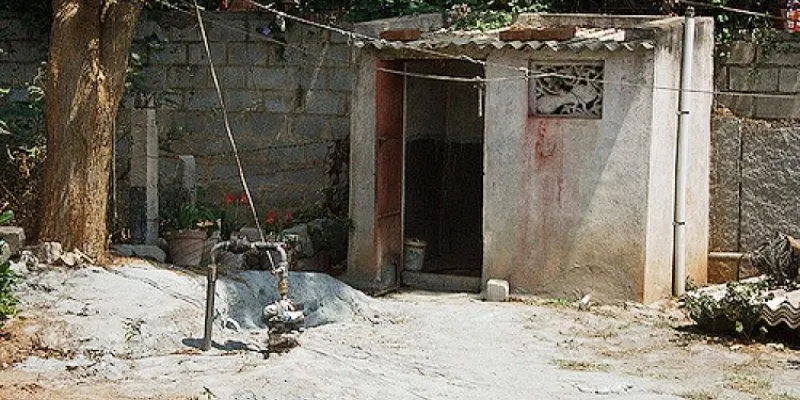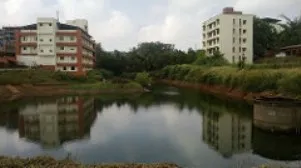What Bengaluru needs to do to fight water crisis
Karnataka, especially Bengaluru, is facing severe water crisis. Rainwater harvesting is the way forward, believe experts.
The next big war is said to be for water, and it might happen sooner than we think. If the current water scenario across Karnataka and most parts of India is anything to go by, we might just be the generation to start this war.

The situation in several parts of Karnataka is a dismal one, to put it mildly. The intense heat coupled with inadequate-to-no water at all leaves us dreading the long harsh summer that is ahead of us. Without water, life simply comes to a standstill. And it has, for many.
According to S. Vishwanath, advisor, Arghyam, there are 160-174 drought-affected areas in Karnataka alone. This means that people living in these areas have little or no water for their daily requirements, including drinking. Reports coming in from various places suggest that farmers are struggling because there is no water for their crops or home or cattle. The various species of wildlife are left with barely any resources to survive.
Is the crisis for real? Do we have no water at all or have we failed to efficiently manage water?
It might come as a surprise to many that we are facing this crisis despite the fact that there is more than enough water provided by nature. Let’s take Bengaluru, for example. The reality is that the city receives enough rainfall annually to meet more than half of the water requirements. According to T. V. Ramachandra of the Energy and Wetlands Research Group at the Indian Institute of Science (IISc) who has coauthored the report titled, Water Situation in Bengaluru, published in October 2016, 70 percent of the city’s water needs can be met by rainfall alone.
“Bangalore requires an average of 18-20TMC (1,000 million cubic feet) of water annually. Of this, rainfall has the potential to meet at least 15TMC, while the remaining can be sourced from the treatment of sewage. Rooftop harvesting will cater to household requirements, whereas groundwater recharge through rejuvenation of lakes can go a long way in meeting this requirement for the entire city. With the city receiving an average of 750-800mm of rainfall in a year, efficient watershed programmes across the city can generate at least 15TMC of water. Treatment of wastewater can generate another 16TMC. Together, these can generate over 30TMC of water annually, which is far more than the city's requirement. So, where is the question of shortage,” asks Dr Ramachandra.
For A. R. Shivakumar, senior scientist, Karnataka State Council for Science and Technology (KSCST), IISc, the current water situation is alarming. He says, “The usual sources of water collected and stored in lakes, dams and tanks are below average. In the last two decades, we have indiscriminately extracted and abused groundwater and reversing that, although not an easy task, has to be done. We have to judicially use every drop of water to tide over this crisis.”

“Due to rapid urbanisation, infiltration of rainwater into the subsoil has decreased drastically and recharging of groundwater has diminished,” adds Shivakumar.
Harvest rain, reap the result
Rainwater harvesting is not just a solution but the only solution if we need to secure the future of water in both urban and rural areas, says S. Vishwanath. “Karnataka is dependent on groundwater resources obtained from rain. We are dependent on it and how we manage rain will help us with soil management as well. The state has 36,000 tanks and it makes sense to be equipped to refuel these tanks for uniform distribution of water,” he added.
According to KSCST, the potential for rainwater harvesting in urban areas is huge. They take a residential site of 40X60 feet (an area of 2,400sqft or 223sqm.) to explain how much rainwater can be harvested. In an area of this size, around 2,23,000 litres of rainwater can be captured in a location where the rainfall is around 1,000mm.
There is good potential and if more and more households can adopt this, shortage of water will hardly exist. Vishwanath doesn’t believe that the responsibility lies solely with the government. “Citizens need to become a part of the solution. There are communities across residential areas in the city that work towards lake rejuvenation in their locality. They adopt lakes and persevere them. We need active citizenship,” he adds.
The citizens too agree with this. "It's important for every household and company to take it (rainwater harvesting) up, and that's the only sensible way towards preserving and consuming water apart from recycling grey and black water. I haven't done it yet but this year before the rains, I do plan to install a few drums everywhere that will catch water through gravity from the roof and every other outlet possible," says resident Achala Paani.
Another resident, Saina Jayapal, agrees. "The policy for rainwater harvesting exists in Bengaluru but there is no implementation. It is an eyewash here, with people taking no effort at all and the government not caring about this issue. It has to be a government policy with strict implementation but also an initiative taken by the people of this city and the state," she says.
Decentralised, sustainable projects are also the need of the hour, feels Shivakumar whose home runs entirely on rainwater, with absolutely no dependency on water from the government agency. He offers basic solutions that every household can adopt to increase self-sufficiency and reduce the burden on the one resource we currently rely on for our water needs.
The IISc report outlines what the city needs when it states that lakes are the optimal means of rainwater harvesting at the community level. “Rejuvenating lakes and undertaking large-scale watershed programmes that involve both the maintenance of catchment areas as well as retaining water in the lake are what can enable the city to overcome this issue of water shortage,” says Dr Ramachandra, who emphasises on the five Rs—retain, rejuvenate, recycle, reuse and responsible citizens—for a solution.
The future of water
Land use prediction using Agent-Based Modelling, according to the IISc report, has shown that the built-up area in Bengaluru would increase to 93.3 percent by 2020 and will be almost on the verge of saturation. This is also an indication of the lack of natural resources that will be available to people residing here.
The IISC report says that the effective model of “decentralised harvesting of water and reuse of treated sewage is not an attractive proposition for the current breed of decision makers with the colonial style of functioning/mindset”. The report goes on to say that the financial gain is much higher in the case of mega projects compared to these decentralised models and a reason for the local administrators to degrade decentralised water harvesting structures and alienate the local community. The main reason for the deliberate inefficient management of water resources, according to the report, is to maximise the net return for the ruling class themselves than the overall growth of the region with water security.
Maybe we can prevent this war for water from happening by being responsible and altruistic, with cooperation from the government. Till that happens, those who are reeling under water shortage have a long and painful wait before getting any respite.
Disclaimer: This article, authored by Madhumitha B, was first published in India Water Portal.







